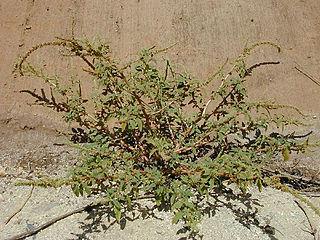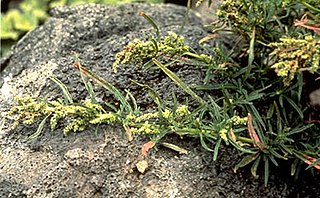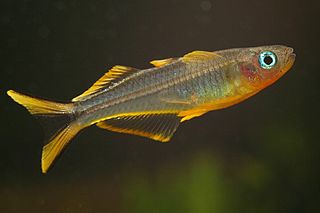
ghvknkb

Amaranthaceae is a family of flowering plants commonly known as the amaranth family, in reference to its type genus Amaranthus. It includes the former goosefoot family Chenopodiaceae and contains about 165 genera and 2,040 species, making it the most species-rich lineage within its parent order, Caryophyllales.

Amaranthus hybridus, commonly called green amaranth, slim amaranth, smooth amaranth, smooth pigweed, or red amaranth, is a species of annual flowering plant. It is a weedy species found now over much of North America and introduced into Europe and Eurasia.

Amaranthus caudatus is a species of annual flowering plant. It goes by common names such as love-lies-bleeding, pendant amaranth, tassel flower, velvet flower, foxtail amaranth, and quilete.

Amaranthus hypochondriacus is an ornamental plant commonly known as Prince-of-Wales feather or prince's-feather. Originally endemic to Mexico, it is called quelite, blero and quintonil in Spanish.

Amaranthus spinosus, commonly known as the spiny amaranth, spiny pigweed, prickly amaranth or thorny amaranth, is a plant is native to the tropical Americas, but is present on most continents as an introduced species and sometimes a noxious weed. It can be a serious weed of rice cultivation in Asia.

Amaranthus retroflexus is a species of flowering plant in the family Amaranthaceae with several common names, including red-root amaranth, redroot pigweed, red-rooted pigweed, common amaranth, pigweed amaranth, and common tumbleweed.

Amaranthus albus is an annual species of flowering plant. It is native to the tropical Americas but a widespread introduced species in other places, including Europe, Africa, and Australia.

The swallow-tailed gull is an equatorial seabird in the gull family, Laridae. It is the only species in the genus Creagrus, which derives from the Latin Creagra and the Greek kreourgos which means butcher, also from kreas, meat; according to Jobling it would mean "hook for meat" referring to the hooked bill of this species. It was first described by French naturalist and surgeon Adolphe-Simon Neboux in 1846. Its scientific name is originally derived from the Greek word for gull, "Glaros" and via Latin Larus, "gull" and furca "two-tined fork". It spends most of its life flying and hunting over the open ocean. The main breeding location is in the Galápagos Islands, particularly the rocky shores and cliffs of Hood, Tower and Wolf Islands, with lower numbers on most of the other islands. It is more common on the eastern islands where the water is warmer.

Amaranthus brownii was an annual herb in the family Amaranthaceae. The plant was found only on the small island of Nihoa in the Northwestern Hawaiian Islands, growing on rocky outcrops at altitudes of 120–215 m (394–705 ft). It was one of nine species of Amaranthus in the Hawaiian Islands, as well as the only endemic Hawaiian species of the genus. It is now considered extinct.

The short-billed pipit is a species of bird in the family Motacillidae.

The fork-tailed tody-tyrant or fork-tailed pygmy tyrant is a species of bird in the family Tyrannidae. It is endemic to Brazil.

The forktail blue-eye is a species of fish in the subfamily Pseudomugilinae. It is endemic to Papua New Guinea south-east of Popondetta, where found in rainforest streams.
Amaranthus anderssonii is a species of plant in the family Amaranthaceae. It is endemic to Ecuador.

Amaranthus sclerantoides is a species of plant in the family Amaranthaceae. It is endemic to Ecuador.

Amaranthus tuberculatus, commonly known as roughfruit amaranth, rough-fruited water-hemp, tall waterhemp, or common waterhemp, is a species of flowering plant. It is a summer annual broadleaf with a germination period that lasts several months. Tall waterhemp has been reported as a weed in 40 of 50 U.S. states.
Bufoides meghalayanus is a species of toad in the family Bufonidae, the true toads. It is also known as the Mawblang toad, rock toad, or Khasi Hills toad. It is endemic to northeastern India where it is known from Meghalaya and Mizoram. However, records from Mizoram may represent an undescribed species, and this species might have a very restricted range in the Khasi Hills near Cherrapunji.
Cyclocheilichthys furcatus, the Mekong giant barb, is a species of cyprinid fish in the genus Cyclocheilichthys found in the Mekong.
The Mount Coke false shieldback is a tettigoniid orthopteran that is endemic to a single small locality in Eastern Cape Province, South Africa. It has not been seen since its original discovery in 1965.
Condylostylus furcatus is a species of long-legged fly in the family Dolichopodidae.















